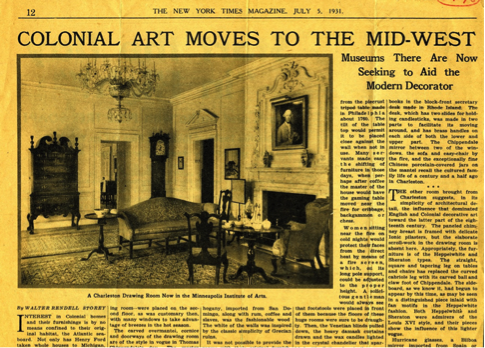In 1931, the Minneapolis Institute of Art received a pair of rooms from the 1772 home of John Stuart, the British Superintendent of Indian Affairs in colonial Charleston, South Carolina. The Charleston Dining and Drawing Rooms, as they’re now known, are among the museum’s many period rooms, historic interiors that were disassembled in their original homes and reconstructed for display in the galleries. Since their arrival in Minneapolis, Stuart’s rooms have been used to present the history of decorative arts in the American colonies.

The newly opened Charleston Dining and Drawings Rooms, described by Walter Rendell Storey in the New York Times on July 5, 1931.
By focusing on the domestic trappings of the well-to-do, the history of colonial-era America told in the Charleston rooms is almost by default a white, Euro-American one. It is a history that many hold dear. In fact it was partly nostalgia for this version of history that fueled the wave of American period rooms installed in U.S. museums from around 1900 to 1930. It is also a history that, on its face, is woefully inaccurate, and that’s especially true of the Charleston rooms.
In colonial South Carolina, Stuart was King George III’s Superintendent of Indian Affairs, charged with keeping the peace between European settlers and Native American tribes, including the Cherokee and Creek Nations. He spent many years in Cherokee territory, beyond the Appalachian Mountains, and even fathered a Cherokee son.
He also owned plantations worked by at least 200 enslaved African men and women. He was like most of his fellow South Carolina plantation owners: he wanted to grow rice in the brackish tidal marshes of the coast and had absolutely no idea how to do it. Growing rice is no easy thing. And so he forced others to do it instead, people from the so-called “Rice Coast” of West Africa, stretching from Senegal to Angola, who had perfected the complexities of rice cultivation over millennia. Stuart and his fellow plantation owners recognized and valued this uniquely African skillset and knowledge base, and paid a hefty premium for African prisoners from these societies.
Here was a man—and a house—whose very existence was predicated on the presence of Africans and Native Americans in colonial-era America. And yet those lives—those cultures and histories—have never been present in the museum’s display of his home.

Native American baskets as part of the new installation “The Many Voices of Colonial America” in the Charleston Dining and Drawing Rooms.
This summer, Mia reinstalled the Charleston Dining and Drawing Rooms with a new exhibition, “The Many Voices of Colonial America.” It’s part of a series of projects that rethink what histories are presented, and how, in the museum’s period rooms.
Those other lives, of Africans and Native Americans, that intersected with Stuart’s are now illuminated in these rooms. Mia worked for years with these communities to bring them out of the shadows, people like Beverly Bushyhead (Eastern Band of Cherokee Indians), John Stuart’s indirect descendant; the artists Shan Goshorn (Eastern Band of Cherokee Indians) and Lisa Rutherford (Cherokee Nation); Jonathan Rose, whose ancestors were forcibly relocated to North America and then later returned to Sierra Leone; Pierre Thiam, a New York-based Senegalese chef and Atlantic World culinary historian; and Henrietta Snype, a fifth-generation basketry artist whose ancestors were brought to South Carolina from Africa.
Museums can offer this kind of complexity, with help from those largely written out of history, as a counterpoint to the simplistic American origin story that many of us were taught as children. But that story is a tenacious one. It has recently been given fresh legs as questions like “What is America?” and “Who is an American?” have been repeatedly raised in the past year, mostly for rhetorical purposes, as a political bludgeon to provoke fear, resentment, and hatred within American society.
The effects of that rhetoric are real. Hate crimes against ethnic, religious, and racial minorities are on the upswing (Slate keeps this handy online tally). White nationalist groups are emboldened and growing in size, and they have seized on certain monuments as symbols of their whitewashed version of American history and cultural identity. They are engaged in a battle, violent and otherwise, over the symbolic terrain of American history and culture.
If museums are arbiters of history, then it’s inevitable that they will be drawn into this fight. And I don’t think we should shrink from it or simply play defense. Museums are in a position to debate the past, on behalf of those who have much at stake, and we can draw very different conclusions—based on facts—than those who choose to see it differently.
During this month of July, when we traditionally celebrate the founding of the United States of America, it’s important to state and restate, and then state again, that the rhetoric and passion behind resurgent White nationalism reflects a profound ignorance of American history. It perpetuates a deeply flawed notion of what “America” has been and is today.
“The Many Voices of Colonial America” is a rebuttal. The Charleston rooms now appear to tell multiple stories, but of course they really tell one story: the story of “America,” in all its complexity and confusion, its barbarity and grace, its beauty and ugliness.
Top image: The newly reinstalled Charleston Drawing Room at Mia, with artworks by historic and current Cherokee, Choctaw, and Euro-American artists.

